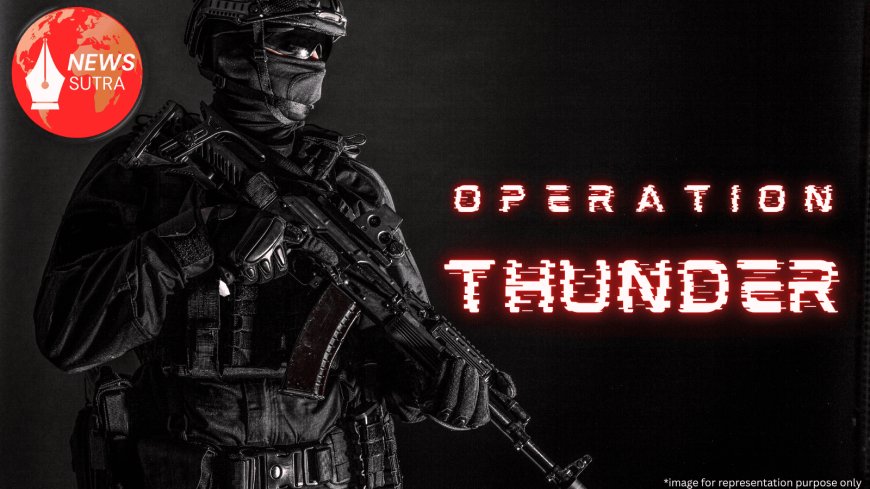Nagpur’s ‘Operation Thunder’ Cracks Down on Narcotics: 730 Arrests, Drugs Worth ₹8.6 Crore Seized in 473-Day Blitz
Over 473 days, Nagpur Police arrested 730 individuals and seized ₹8.6 crore in drugs during Operation Thunder, a landmark crackdown on narcotics.

Nagpur, June 26, 2025 — In one of Maharashtra’s most extensive anti-narcotics campaigns in recent years, the Nagpur Police have successfully concluded Operation Thunder, a 473-day mission that resulted in the arrest of 730 individuals and the seizure of drugs valued at ₹8.6 crore. The massive crackdown, led by the city’s Anti-Narcotics Cell (ANC), has been hailed as a model operation by both state and central agencies in combating urban drug networks.
What Was Operation Thunder?
Launched in February 2024, Operation Thunder was a multi-agency initiative involving city police, the Narcotics Control Bureau (NCB), the Maharashtra Anti-Terrorism Squad (ATS), and intelligence input from the Ministry of Home Affairs. The operation targeted peddlers, distributors, interstate trafficking rings, and dark web-based drug supply chains operating across Vidarbha.
The operation’s scope was unprecedented for the city:
-
473 days of surveillance, raids, and intelligence-gathering
-
94 narcotics-related FIRs registered under NDPS Act, 1985
-
730 arrests including repeat offenders and two major interstate kingpins
-
Confiscated substances include MDMA, Mephedrone, Cocaine, LSD blotters, Heroin, and Cannabis derivatives
More details on the NDPS Act under which these cases were booked can be found on the National Crime Records Bureau portal.
Drugs Worth ₹8.6 Crore Seized
The total seizure, according to Police Commissioner Amitesh Kumar, includes both processed narcotics and precursor chemicals.
“This is not just about seizure, but dismantling the financial ecosystem of drug cartels. A good portion of the cash flow has been frozen under the Prevention of Money Laundering Act,” Kumar stated during a press briefing.
Key recoveries included:
-
2.3 kg of MDMA
-
1.1 kg of Cocaine
-
5.6 kg of Mephedrone (Meow Meow)
-
LSD blotters worth ₹40 lakh
-
₹1.9 crore in cash
-
Cryptocurrency wallets suspected to be used for darknet purchases
Digital evidence is being further examined by Maharashtra Cyber Crime Division. For related trends in India’s darknet drug markets, refer to this study by ORF.
Targeting Supply Chains and Youth Networks
The operation paid particular focus to the youth demographic, especially in colleges, hostels, and co-working hubs. Undercover officers posed as customers, leading to successful arrests in and around Dharampeth, Sitabuldi, Ramdaspeth, and MIHAN zones.
According to DCP (Crime) Chinmay Pandit, “Roughly 38% of those arrested were under the age of 30. Most were first-time peddlers lured by quick profits.”
Awareness programs have since been launched in partnership with Rashtrasant Tukadoji Maharaj Nagpur University (RTMNU) and Narcotics Anonymous India, aiming to both rehabilitate users and prevent further recruitment.
Political, Public and Judicial Reactions
The operation has received bipartisan support. Maharashtra Deputy CM Devendra Fadnavis praised the city police’s resolve, stating, “Nagpur has set a new benchmark for urban policing. We’ll expand Operation Thunder to other cities like Pune and Aurangabad.”
At the judicial level, the Nagpur Bench of Bombay High Court has been monitoring drug cases with greater scrutiny. In a recent bail hearing, Justice Vinay Joshi remarked, “The sheer scale of drug infiltration in educational institutions is deeply alarming.”
For legal interpretations and bail proceedings under the NDPS Act, Live Law offers detailed case updates and expert commentary.
Role of Technology and Intelligence Sharing
Operation Thunder made heavy use of automated number plate recognition (ANPR), facial recognition systems (FRS), and data triangulation across telecom and financial records.
Police also coordinated with platforms like Instagram, Telegram, and WhatsApp to monitor encrypted communications. Over 60 accounts were flagged for suspicious activity, with meta-data now being assessed by CERT-In and other cyber forensic teams.
The use of AI-based surveillance tools was piloted for the first time in Nagpur during this operation, a model now being considered by the Bureau of Police Research and Development (BPRD). More on police modernization initiatives can be found on the BPRD’s official website.
What's Next: Sustained Vigilance and Rehabilitation
Nagpur Police Commissionerate has announced the establishment of a dedicated narcotics enforcement wing to build on the success of Operation Thunder. Plans are also underway to:
-
Expand de-addiction centers in partnership with Ministry of Social Justice and Empowerment
-
Launch a citywide “Drug-Free Nagpur” campaign
-
Set up hotlines for anonymous tips
-
Integrate anti-drug education modules in municipal schools
Local NGOs like Sankalp and Kripa Foundation will play key roles in outreach and rehabilitation.
For readers looking to understand the broader context of India’s narcotics control policies, the UNODC’s India Country Profile provides valuable insights.
Conclusion: A City Takes a Stand
Operation Thunder stands as a defining moment in Nagpur’s law enforcement history — not just in terms of arrests and seizures, but for igniting a community-led response to a growing national crisis. The sheer scale and sophistication of the campaign have set the tone for similar interventions across India.
Whether this operation leads to lasting change depends on sustained political will, continuous public awareness, and ongoing police reform — all of which seem to be taking root in Maharashtra’s winter capital.














